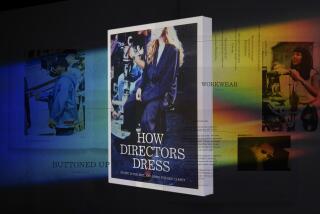He wore the suit; did he fill the shoes?
- Share via
At the cafeteria, if you can call it that, on the fourth floor of the Conde Nast building in Times Square, roast sirloin and purple Peruvian potatoes with tarragon aioli are on the menu. The food is not all that is chic. The walls are bluish and wavy; some are glass. The men and women seated at leather banquettes around the tables are extraordinarily attractive. Still, it feels like any other cafeteria-cum-fishbowl. Everyone is checking each other out. It could be high school -- or a gussied-up Denny’s.
This modish cafeteria, three new magazines about shopping (two successful; one yet to be launched) -- and not much more -- remain the legacy of an elusive Englishman named James Truman, who held the mythic title “editorial director” at Conde Nast for 11 years. Two weeks ago Truman quit, according to an official press release. The man who had arguably the best job in magazines was returning to the Continent. He wanted to learn Spanish.
By any normal standards, Truman had a dream job. It reportedly paid him $2 million a year, came with fabulous perks and by job description made him taste master over 17 glossy magazines, including Gourmet and Glamour, Bride’s, GQ and Allure. While he apparently was under instructions to steer clear of the autonomous editors-in-chief of the big three in the magazine stable -- Vogue, Vanity Fair and the New Yorker -- and from other parts of the empire such as Fairchild Publications, there was still plenty to do.
He was tinkerer-in-chief. He created three magazines, killed three others and initiated regime change at one or two more. Also on Truman’s resume was the company’s move to a Times Square skyscraper. He oversaw its interior design, including that of the wavy-walled cafeteria by Frank Gehry.
It’s difficult to know what to make of Truman’s successes and failures, his effect on this multibillion-dollar empire, as they are measured up and down Midtown’s 6th Avenue, where most of America’s popular magazines emerge monthly.
Certainly, the mood last week at Conde Nast was not funereal the way it was 11 years ago when then-81-year-old Alexander Liberman departed and was replaced by Truman, then 36. Liberman had invented and held the title of “editorial director” of Conde Nast for about 30 years, intimidating and inspiring so many along the way that when he left, the void was immense. (He died a few years later.)
As one regular in the cafeteria said of the reaction to Truman’s departure: “You can’t mourn someone you didn’t know, who has no real legacy.” Another who worked with and respected both Truman and Liberman said, “Alex let people feel they had some kind of relationship with him, versus James, who made everybody feel they didn’t have a relationship with him. No wonder there’s no big uproar that he’s gone.”
In New York, sometimes there’s a job with a title that becomes outsized because of the person who occupies it. For example, the title of “commissioner of parks” in this city was a lot more important when it was held by the great urban planner and powerbroker Robert Moses. “Coach of the New York Knicks” had similar clout in the Red Holzman championship years and “conductor of the New York Philharmonic” had more cachet when it was Leonard Bernstein.
Liberman embodied the title “editorial director” of a magazine empire. But just as Hollywood is long past the era of major studio moguls such as Louis B. Mayer and Jack Warner, the magazine world has changed since Liberman moved on. His former title carries on and the people in it are treated as a big deal. But now really it’s just a job for another suit.
Even Liberman’s successor once-removed, the very worthy Thomas Wallace, who is taking over for Truman, admitted last week he’s no Alexander Liberman.
“Alex was a genius and he had a great eye and his background was in design,” said Wallace, who is 55 and a former editor of Conde Nast Traveler. “He could look at almost any page of any magazine and have an opinion about it, and he was not reluctant to express himself. I’m not in my 70s or 80s, not Russian, my background is not in design. I do expect my approach to the job will be different.”
Wallace has been praised as a superb administrator and manager, a calm and orderly force in a magazine world plagued by hyper-mischievous people. He is Ivy League and cordial, not Machiavellian like Liberman. After all, when his job at Conde Nast Traveler became vacant, that could have set off a storm of lobbying among job applicants. But within days of his appointment, Wallace appointed his longtime No. 2 as his successor, leaving no time for deck-chair jumping.
Many have wondered why one of the three really big bears at Conde Nast -- Vogue’s Anna Wintour, Vanity Fair’s Graydon Carter or the New Yorker’s David Remnick -- did not inherit the big chair this time around. The conventional wisdom is that Conde Nast’s chairman, S.I. Newhouse Jr., wanted to keep the people running his most successful franchises in place, doing what they do best. So the No. 4 editor became editorial director.
No one would have ever thought of Alexander Liberman as a No. 4 at anything.
The change at Conde Nast, a privately held company, happened with some precision, if you believe the wags. (And no skyscraper in Manhattan is as chockablock with energetic wags as Conde Nast headquarters.)
The Monday after the New Year, Truman apparently announced to his boss he was quitting.
Newhouse, an elusive billionaire, was said to have been taken by surprise. There had been grumblings that Truman was adrift. In recent years, he’d revealed that he was seeking new inspirations. He went on a monthlong retreat to a Buddhist monastery and took up writing journalism again, producing a long article for Conde Nast Traveler on Iran. Truman also recently created a prototype for a new magazine about the art world that was announced in August but apparently never got a green light from Newhouse.
And so the next day, Truman was spotted leaving Conde Nast, possibly for the last time. That day Wallace, who worked on the 14th floor, was called to the corporate suite on 11.
“Si and I had been talking about the impact of the tsunami on travel, so I figured that’s what he wanted to discuss,” Wallace recalled last week during a phone interview from Palm Beach, Fla., where he was meeting with Conde Nast executives.
But according to Wallace, Newhouse came right out with it.
“How would you like to be editorial director of Conde Nast?” Newhouse asked. Wallace pointed out that someone else had the job. After Newhouse explained that Truman had resigned, Wallace, a former newspaper editor, asked two questions:
What is the job? Why me?
Within seconds of hearing Newhouse’s explanations, which Wallace chose not to share with a reporter, Wallace signed on.
“I stand at the pinnacle in the world of magazines, and it’s thrilling to me right up to the point of “ -- Wallace paused for a deep breath -- “terror.”
“But I do know most of the editors who work in that building,” he continued, “and I know them all to be experts in what they do and passionate about what they do. I’ll be hanging out with them, learning from them.”
It’s interesting to note that with Tom Wallace’s ascension to the Conde Nast corporate suite, the operation now has a second nuts-and-bolts-type person running things. Last year an executive named Chuck Townsend, who has a similar reputation for sound fiscal judgment, replaced Steve Florio as chief executive. Could this mean there will be financial restraints placed on even the untouchable editors such as Anna and Graydon, and that three editorial assistants won’t be going along on a photo shoot with some celebrity?
Not so far.
On the elevator going up to Vogue’s office on 12 the other day, a handsome young man with his shirttails hanging over his jeans clutched a thick envelope of airline tickets.
“Where are you going?” a woman asked him.
“Miami for a photo shoot with Bruce Weber,” he said. “Everyone is going. Everyone.”






